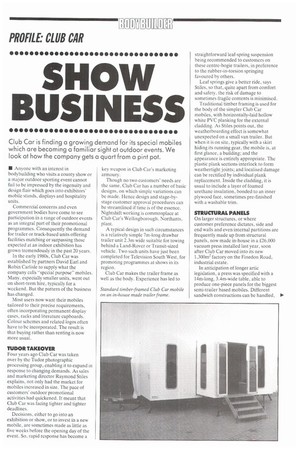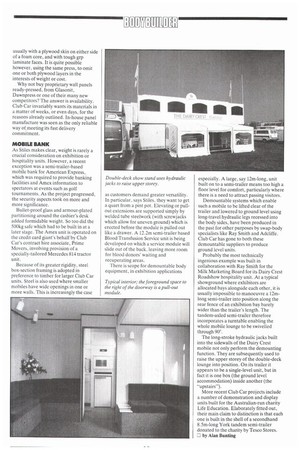SHO BUSIN SS
Page 123

Page 125

If you've noticed an error in this article please click here to report it so we can fix it.
• Anyone with an interest in bodybuilding who visits a county show or a major outdoor sporting event cannot fail to be impressed by the ingenuity and design flair which goes into exhibitors' mobile stands, displays and hospitality units.
Commercial concerns and even government bodies have come to see participation in a range of outdoor events as an integral part of their promotional programmes. Consequently the demand for trailer or truck-based units offering facilities matching or surpassing those expected at an indoor exhibition has grown tremendously in the past 20 years.
In the early 1980s, Club Car was established by partners David Earl and Robin Carlisle to supply what the company calls "special purpose" mobiles. Many, especially smaller units, went out on short-term hire, typically for a weekend. But the pattern of the business has changed.
Most users now want their mobiles tailored to their precise requirements, often incorporating permanent display cases, racks and literature cupboards. Colour schemes and related logos often have to be incorporated. The result is that buying rather than renting is now more usual.
Four years ago Club Car was taken over by the Tudor photographic processing group, enabling it to expand in response to changing demands. As sales and marketing director Raymond Stiles explains, not only had the market for mobiles increased in size. The pace of customers' outdoor promotional activities had quickened. It meant that Club Car was facing tighter and tighter deadlines.
Decisions, either to go into an exhibition or show, or to invest in a new mobile, are sometimes made as little as five weeks before the opening day of the event. So, rapid response has become a key weapon in Club Car's marketing armoury.
Though no two customers' needs are the same, Club Car has a number of basic designs, on which simple variations can bc made. Hence design and stage-bystage customer approval procedures can be streamlined if time is of the essence. Nightshift working is commonplace at Club Car's Wellingborough, Northants, plant.
A typical design in such circumstances is a relatively simple 7m-long drawbar trailer unit 2.3m wide suitable for towing behind a Land-Rover or Transit-sized vehicle. Two such units have just been completed for Television South West, for promoting programmes at shows in its region.
Club Car makes the trailer frame as well as the body. Experience has led to straightforward leaf-spring suspension being recommended to customers on these centre-bogie trailers, in preference to the rubber-in-torsion springing favoured by others.
Leaf springs give a better ride, says Stiles, so that, quite apart from comfort and safety, the risk of damage to sometimes fragile contents is minimised.
Traditional timber framing is used for the body of the simpler Club Car mobiles, with horizontally-laid hollow white PVC planking for the external cladding. As Stiles points out, the weatherboarding effect is somewhat unexpected on a small van trailer. But when it is on site, typically with a skirt hiding its running gear, the mobile is, at first glance, a building; and the appearance is entirely appropriate. The plastic plank sections interlock to form weathertight joints; and localised damage can be rectified by individual plank replacement. Inside the cladding, it is usual to include a layer of foamed urethane insulation, bonded to an inner plywood face, sometimes pre-finished with a washable trim.
On larger structures, or where
customer preference dictates, side and end walls and even internal partitions are frequently made up from structural panels, now made in-house in a £26,000 vacuum press installed last year, soon after Club Car moved into its new 1,300m2 factory on the Finedon Road, industrial estate.
In anticipation of longer artic legislation, a press was specified with a 14m-long, 3.4m-wide table, able to produce one-piece panels for the biggest semi-trailer based mobiles. Different sandwich constructions can be handled, usually with a plywood skin on either side of a foam core, and with tough grp laminate faces. It is quite possible however, using the same press, to omit one or both plywood layers in the interests of weight or cost.
Why not buy proprietary wall panels ready-pressed, from Glasonit, Dawnpress or one of their many new competitors? The answer is availability. Club Car invariably wants its materials in a matter of weeks, or even days, for the reasons already outlined. In-house panel manufacture was seen as the only reliable way of,meeting its fast delivery commitment.
As Stiles makes clear, weight is rarely a crucial consideration on exhibition or hospitality units. However, a recent exception was a semi-trailer-based mobile bank for American Express, which was required to provide banking facilities and Amex information to spectators at events such as golf tournaments. As the project progressed, the security aspects took on more and more significance.
Bullet-proof glass and armour-plated partitioning around the cashier's desk added formidable weight. So too did the 500kg safe which had to be built in at a later stage. The Amex unit is operated on the credit card giant's behalf by Club Car's contract hire associate, Prime Movers, involving provision of a specially-tailored Mercedes 814 tractor unit.
Because of its greater rigidity, steel box-section framing is adopted in preference to timber for larger Club Car units. Steel is also used where smaller mobiles have wide openings in one or more walls. This is increasingly the case
as customers demand greater versatility. In particular, says Stiles, they want to get a quart from a pint pot. Elevating or pullout extensions are supported simply by welded tube steelwork (with screwjacks which allow for uneven ground) which is erected before the module is pulled out like a drawer. A 12.2m semi-trailer based Blood Transfusion Service unit is being developed on which a service module will slide out of the back, leaving more room for blood donors' waiting and recuperating areas.
There is scope for demountable body equipment, in exhibition applications Typical interior; the foreground space to the right of the doorway is a pull-out module. especially. A large, say 12m-long, unit built on to a semi-trailer means too high a floor level for comfort, particularly where there is a need to attract passing visitors.
Demountable systems which enable such a mobile to be lifted clear of the trailer and lowered to ground level using long-travel hydraulic legs recessed into the body sides, have been produced in the past for other purposes by swap-body specialists like Ray Smith and Adcliffe. Club Car has gone to both these demountable suppliers to produce ground level units.
Probably the most technically ingenious example was built in collaboration with Ray Smith for the Milk Marketing Board for its Dairy Crest Roadshow hospitality unit. At a typical showground where exhibitors are allocated bays alongside each other, it is usually impossible to manoeuvre a 12mlong semi-trailer into position along the rear fence of an exhibition bay barely wider than the trailer's length. The tandem-axled semi-trailer therefore incorporates a turntable enabling the whole mobile lounge to be swivelled through 90°.
The long-stroke hydraulic jacks built into the sidewalls of the Dairy Crest mobile not only perform the demounting function. They are subsequently used to raise the upper storey of the double-deck lounge into position. On its trailer it appears to be a single-level unit, but in fact it is one box (the ground level accommodation) inside another (the "upstairs").
More recent Club Car projects include a number of demonstration and display units built for the Australian-run charity Life Education. Elaborately fitted out, their main claim to distinction is that each one is built in the shell of a secondhand 8.5m-long York tandem semi-trailer donated to the charity by Tesco Stores.
by Alan Bunting








































































































































